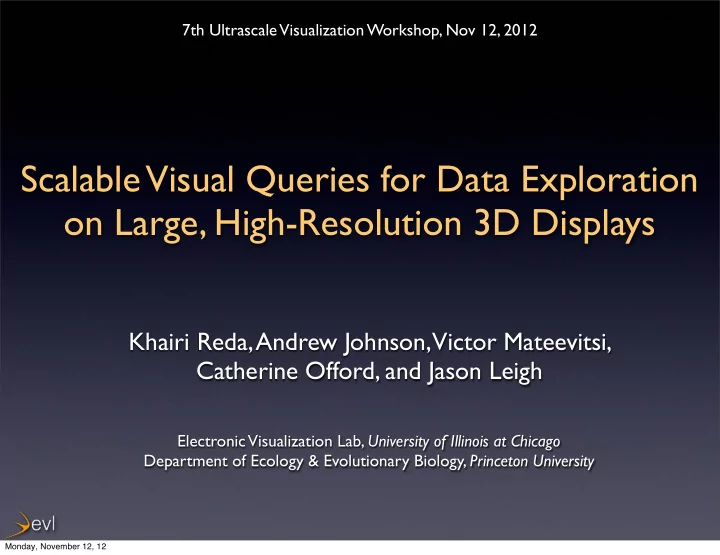

7th Ultrascale Visualization Workshop, Nov 12, 2012 Scalable Visual Queries for Data Exploration on Large, High-Resolution 3D Displays Khairi Reda, Andrew Johnson, Victor Mateevitsi, Catherine Offord, and Jason Leigh Electronic Visualization Lab, University of Illinois at Chicago Department of Ecology & Evolutionary Biology, Princeton University Monday, November 12, 12
Summary • Large, High-Resolution are becoming increasingly common in universities and research labs • These displays have the potential to change scientific workflows • Case study: making sense of insect behavior using Large, High-Res 3D display • A Visual Query approach to data exploration • We need a human-centered approach to develop next generation visual interfaces for these displays Institutions utilizing Large, Hi-Res displays CAVE2 - University of Illinois at Chicago for data visualization and analysis Monday, November 12, 12
Lenses for big data • Context + detail by walking up to or away from the display • Juxtapose lots of views • Promotes embodied cognition Molecular visualization for large nanoscale structures ~5 Million atoms + electron charge density Visualization of cerebral blood vasculature ~80K vessels Monday, November 12, 12
Lenses for big data • We know little about how users utilize these environments in complex sensemaking scenarios Intelligence analysis • Most applications treat these Bradel et al, 2011 displays as a giant Desktop • We need a new generation of scalable visual interfaces to enable scientists to explore and make sense of their data using big displays Cerebral vasculature reconstruction Thomas Marrinan, EVL Monday, November 12, 12
“ To raise new questions, new possibilities, to regard old problems from a new angle requires creative imagination and marks real advance in science ” - Albert Einstein & Leopold Infeld Monday, November 12, 12
Making sense of insect behavior Monday, November 12, 12
Kenyan Seed Making sense of insect behavior Harvester ants To food To nest Monday, November 12, 12
Kenyan Seed Making sense of insect behavior Harvester ants Off-trail ant To food To nest On-trail ant Monday, November 12, 12
Data Monday, November 12, 12
Statistical analysis On trail - ant #183 East of trail - ant #52 110 110 90 90 70 70 50 50 30 30 10 10 10 30 50 70 90 110 130 10 30 50 70 90 110 130 %45 %45 %30 %30 %15 %15 -120 -60 60 120 -120 -60 60 120 Monday, November 12, 12
Making sense of insect behavior • Lots of trajectories ~500 • Stochastic individual behavior • Impossible to make inferences on a case-by- case basis • Complex hypotheses space - many possible theories / narratives • Ecologists want to see entire trajectories Monday, November 12, 12
Visual exploration on a large 3D display Screen surface 19 Megapixels, stereoscopic 3D 7 x 3 meters 22 x 10 feet 2D movement Trajectory Time Monday, November 12, 12
Scalable visual queries Temporal Coordinated filter Brushing Monday, November 12, 12
Scalable visual queries Hypothesis • Ants use celestial cues when navigating off-trail Query • Ants captured east of foraging trail exit from west side when released in attempt to go back to trail West East Monday, November 12, 12
Scalable visual queries • Flexibility in query formulation allows a variety of hypotheses to be explored and put to test quickly in parallel • Pre-attentive encoding of query results allows for quick, ‘scalable perception’ of results • A High-Resolution display allows a large portion of the data to be queries and displayed in parallel Monday, November 12, 12
Sensemaking Pirolli & Card. 2005 • Sensemaking is the process of organizing scattered and incomplete pieces of information, extracting evidence from it, and combining that evidence into a presentation that provides a narrative and interpretation of how this data ties together Monday, November 12, 12
Sensemaking Pirolli & Card. 2005 • Sensemaking is the process of organizing scattered and incomplete pieces of information, extracting evidence from it, and combining that evidence into a presentation that provides a narrative and interpretation of how this data ties together Monday, November 12, 12
Quick representational shifts Monday, November 12, 12
Quick representational shifts West side East side north south Evidence file = individual trajectories Enrich representation Schema = groups of brushed trajectories Monday, November 12, 12
Key points • Visual queries can be an effective approach for data exploration on High-Resolution displays • Multiple hypotheses can be quickly explored and evaluated in parallel • Stereoscopic 3D can be used as an extra perceptual channel even in 2D datasets, particularly when there’s a temporal component Monday, November 12, 12
Khairi Reda www.evl.uic.edu/kreda mreda2@uic.edu Acknowledgments Iain Couzin, Dan Rubenstein, and Tanya Berger-Wolf Depar tment electronic of ecology & visualization evolutionary laboratory biology University of Illinois at Chicago Princeton University Funding provided by National Science Foundation awards OCI-1152895 and OCI-0943559 Monday, November 12, 12
Recommend
More recommend